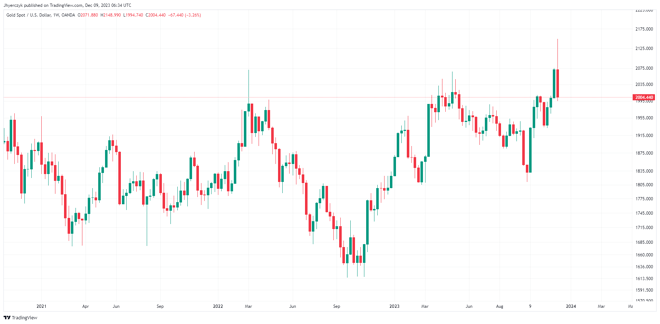Advertisement
Advertisement
Gold Prices Forecast: Traders Weighing Yields, Dollar Strength, Fed Decisions
By:
Gold's (XAU/USD) next move depends on U.S. economic data, labor market strength, and upcoming Fed policy decisions.
Highlights
- Gold falls below $2,000 amid strong U.S. dollar.
- XAU/USD’s future hinged on U.S. dollar and Treasury yields.
- Upcoming Fed decisions crucial for gold’s direction.
Gold Prices Dip Below $2,000
In a significant market shift, gold prices (XAU/USD) retreated below the $2,000 an ounce mark at the close of trading on Friday. This downturn was primarily driven by a strengthening U.S. dollar and surging Treasury yields, as traders adjusted their expectations for U.S. interest rate cuts in light of robust jobs data.
Supply and Demand Dynamics
Spot gold experienced a notable decline, dropping 3.26% and marking its worst performance in ten weeks. This descent comes after gold hit a record high on December 3 at $2,148.99. The fluctuation in gold prices reflects a complex balance of supply and demand factors, heavily swayed by the broader economic environment and investor sentiment.
Economic Indicators and Market Sentiment
Central to this week’s gold price movement was the U.S. economic data, particularly the November jobs report. The report showed unexpected strength in the labor market, with nonfarm payrolls rising by 199,000 last month, exceeding the Dow Jones surveyed economists’ prediction of 190,000. This data, coupled with a decrease in the unemployment rate to 3.7%, underscores a tighter labor market than anticipated, despite the Federal Reserve’s cooling measures.
Geopolitical Factors and Global Decisions
Geopolitical events and policy decisions play a pivotal role in shaping gold market trends. Fed Chairman Jerome Powell’s recent remarks suggested that speculations about imminent rate cuts were premature. This stance, along with the upcoming Federal Reserve meeting, is significantly influencing investor strategies and market forecasts.
Strategic Moves and Policy Decisions
The movement in the gold market also responds to broader financial strategies and policy shifts. The increase in the U.S. dollar index and the recovery of Treasury yields, especially the 10-year note rising to 4.233%, indicate a recalibration of market expectations following the labor market data. These developments have led traders and investors to reassess their positions in gold, anticipating further policy actions from the Federal Reserve.
Short-Term Forecast
The gold market is expected to maintain its volatility in the near term. The Federal Reserve’s forthcoming policy meeting and the release of additional economic indicators like consumer inflation data (CPI) will be critical in shaping the market’s direction. Investors are keenly observing these developments to gauge the potential impact on interest rates and the consequent effects on gold prices.
As traders anticipate clearer interest rate projections from the Federal Reserve’s meeting on December 12-13, they have already started adjusting to potential outcomes. This forward-looking stance, combined with the recent easing already reflected in market prices, indicates that gold could encounter periods of fluctuating investor sentiment and volatile price swings.
About the Author
James Hyerczykauthor
James Hyerczyk is a U.S. based seasoned technical analyst and educator with over 40 years of experience in market analysis and trading, specializing in chart patterns and price movement. He is the author of two books on technical analysis and has a background in both futures and stock markets.
Advertisement
